Field Assessment of Subsurface Intermittent Water Flow via Porous and Emitting Pipes
Abstract
1. Introduction
2. Materials and Methods
2.1. Study Area
2.2. Materials
2.3. Methodology
2.3.1. Plant Water Requirements
2.3.2. Treatments
2.3.3. Soil Water Content Determination
2.3.4. Preparing the Experiment Site
2.3.5. HYDRUS Modeling
3. Results and Discussion
3.1. Soil Characteristics
3.2. Measurement Approaches Validation
3.3. Soil Water Distribution
3.4. Plant Germination Response
3.5. Yield Performance
3.6. Practical Implications
3.7. Study Limitations and Future Work
4. Conclusions
Author Contributions
Funding
Data Availability Statement
Acknowledgments
Conflicts of Interest
References
- Mukhopadhyay, R.; Sarkar, B.; Jat, H.S.; Sharma, P.C.; Bolan, N.S. Soil salinity under climate change: Challenges for sustainable agriculture and food security. J. Environ. Manag. 2021, 280, 111736. [Google Scholar] [CrossRef] [PubMed]
- Tian, Z.; Wang, J.-W.; Li, J.; Han, B. Designing future crops: Challenges and strategies for sustainable agriculture. Plant J. 2021, 105, 1165–1178. [Google Scholar] [CrossRef] [PubMed]
- Jha, S.K.; Ramatshaba, T.S.; Wang, G.; Liang, Y.; Liu, H.; Gao, Y.; Dian, A. Response of growth, yield and water use efficiency of winter wheat to different irrigation methods and scheduling in North China Plain. Agric. Water Manag. 2019, 217, 292–302. [Google Scholar] [CrossRef]
- Olgarenko, V.; Olgarenko, G.; Olgarenko, I. A Method of Integral Efficiency Evaluation of Water Use on Irrigation Systems. In Proceedings of the International Multidisciplinary Scientific GeoConference SGEM 2018, Albena, Bulgaria, 2–8 July 2018; Volume 18, pp. 3–9. [Google Scholar]
- Najafi, P.; Tabatabaei, S. Effect of using subsurface drip irrigation and ET-HS model to increase WUE in irrigation of some crops. Irrig. Drain. 2007, 56, 477–486. [Google Scholar] [CrossRef]
- Subbaiah, R. A review of models for predicting soil water dynamics during trickle irrigation. Irrig. Sci. 2013, 31, 225–258. [Google Scholar] [CrossRef]
- Martínez, J.; Reca, J. Water use efficiency of surface drip irrigation versus an alternative subsurface drip irrigation method. J. Irrig. Drain. Eng. 2014, 140, 04014030. [Google Scholar] [CrossRef]
- Alazba, A.A.; Mattar, M.A.; El-Shafei, A.; Radwan, F.; Ezzeldin, M.; Alrdyan, N. Comparative Analysis of ANN, GEP, and Water Advance Power Function for Predicting Infiltrated Water Volume in Furrow of Permeable Surface. Water 2025, 17, 1304. [Google Scholar] [CrossRef]
- Gültekin, R.; Ertek, A. The Effect of Intermittent Subsurface Drip Irrigation on Soil Water Distribution. Water Conserv. Sci. Eng. 2024, 9, 21. [Google Scholar] [CrossRef]
- Jin, Y.; Gao, X.; Zhang, R.; Wu, X.; Long, H.; Sun, Z.; Zhang, S. Comprehensive assessment of plant and water productivity responses in negative pressure irrigation technology: A meta-analysis. Agronomy 2022, 12, 1925. [Google Scholar] [CrossRef]
- Ayars, J.; Bucks, D.A.; Lamm, F.R.; Nakayama, F.S. Introduction, Micro irrigation for crop production design, operation and management. In Developments in Agricultural Engineering; Lamm, F.R., Ayars, J.E., Nakayama, F.S., Eds.; Elsevier: Amsterdam, The Netherlands, 2007; pp. 473–551. [Google Scholar]
- Singh, K.; Mishra, S.K.; Brar, A.S. Optimizing Sugarcane and Water Productivity Through Surface and Subsurface Drip Fertigation in Subtropical India. Sugar Tech 2023, 26, 63–76. [Google Scholar] [CrossRef]
- Vadar, H.; Pandya, P.; Patel, R. Effect of subsurface drip irrigation depth scheduling in summer Okra. Emergent Life Sci. Res. 2019, 5, 52–61. [Google Scholar] [CrossRef]
- Salisu, A.; Abdallah, A.F.; Wayayok, A.; Kamal, R.M. Discharge characterization and variability determination along shorter sections of soaker hose pipe for soil column experiment. Basrah J. Agric. Sci. 2021, 34, 92–99. [Google Scholar] [CrossRef]
- Rasheed, Z. Modeling of subsurface horizontal porous pipe irrigation under different conditions. Iraqi J. Agric. Sci. 2021, 52, 949–959. [Google Scholar] [CrossRef]
- Junpunya, M.; Ou-udomying, B.; Amornsakchai, T.; Jangchud, I. Study of porous rubber pipes reinforced with waste tire fiber and pineapple leaf fiber for smart irrigation system. In IOP Conference Series: Materials Science and Engineering; IOP Publishing: Bristol, UK, 2022. [Google Scholar]
- Rasheed, Z. Investigating the Effect of Saturated Hydraulic Conductivity in Porous Pipe Irrigation System and Comparing to Other Parameters. In IOP Conference Series: Earth and Environmental Science; IOP Publishing: Bristol, UK, 2023. [Google Scholar]
- Appels, W.M.; Karimi, R. Analysis of soil wetting patterns in subsurface drip irrigation systems–indoor alfalfa experiments. Agric. Water Manag. 2021, 250, 106832. [Google Scholar] [CrossRef]
- Elmaloglou, S.; Diamantopoulos, E.; Dercas, N. Comparing soil moisture under trickle irrigation modeled as a point and line source. Agric. Water Manag. 2010, 97, 426–432. [Google Scholar] [CrossRef]
- Patel, N.; Rajput, T. Effect of drip tape placement depth and irrigation level on yield of potato. Agric. Water Manag. 2007, 88, 209–223. [Google Scholar] [CrossRef]
- Lozano, D.; Ruiz, N.; Baeza, R.; Contreras, J.I.; Gavilán, P. Effect of pulse drip irrigation duration on water distribution uniformity. Water 2020, 12, 2276. [Google Scholar] [CrossRef]
- Mohammed, A.K.; Abed, B.S. Water distribution and interference of wetting front in stratified soil under a continues and an intermittent subsurface drip irrigation. J. Green Eng. 2020, 10, 268–286. [Google Scholar]
- Zamora, V.R.O.; da Silva, M.M.; da Silva, G.F.; Santos Junior, J.A.; Menezes, D.; de Menezes, S.M. Pulse drip irrigation and fertigation water depths in the water relations of coriander. Hortic. Bras. 2019, 37, 22–28. [Google Scholar] [CrossRef]
- Kilic, M. A new analytical method for estimating the 3D volumetric wetting pattern under drip irrigation system. Agric. Water Manag. 2020, 228, 105898. [Google Scholar] [CrossRef]
- Gültekin, R.; Ertek, A. Effect of Pulse Subsurface Drip Irrigation on Yield and Quality Parameters of Sillage Maize (Zea Mays L.). Anadolu Tarım Bilim. Derg. 2022, 37, 459–478. [Google Scholar]
- Yuan, B.-Z.; Nishiyama, S.; Kang, Y. Effects of different irrigation regimes on the growth and yield of drip-irrigated potato. Agric. Water Manag. 2003, 63, 153–167. [Google Scholar] [CrossRef]
- Ruskin, R. Subsurface Drip Irrigation and Yields; Geoflow Inc.: Corte Madera, CA, USA, 2000. [Google Scholar]
- Lal Mehriya, M.; Geat, N.; Sarita; Singh, H.; Mattar, M.A.; Elansary, H.O. Response of drip irrigation and fertigation on cumin yield, quality, and water-use efficiency grown under arid climatic conditions. Agronomy 2020, 10, 1711. [Google Scholar] [CrossRef]
- De Almeida, W.F.; Lima, L.A.; Pereira, G.M. Drip pulses and soil mulching effect on American crisphead lettuce yield. Eng. Agric. 2015, 35, 1009–1018. [Google Scholar] [CrossRef]
- Madane, D.A. Advancement of pulse irrigation (drip) in sandy soil. Think India J. 2019, 22, 692–698. [Google Scholar]
- Thompson, C. Irrigation and Intensive Large-Scale Crop Management. In Proceedings of the 10th Australian Agronomy Conference, Hobart, Australia, 29 January–1 February 2001. [Google Scholar]
- Oron, G. Simulation of water flow in the soil under sub-surface trickle irrigation with water uptake by roots. Agric. Water Manag. 1981, 3, 179–193. [Google Scholar] [CrossRef]
- Bakeer, G.; El-Ebabi, F.G.; El-Saidi, M.T.; Abdelghany, A.R.E. Effect of pulse drip irrigation on yield and water use efficiency of potato crop under organic agriculture in sandy soils. Misr J. Agric. Eng. 2009, 26, 736–765. [Google Scholar] [CrossRef]
- Li, Y.; Niu, W.; Wang, J.; Xu, J.; Zhang, M.; Li, K. Review on advances of airjection irrigation. Int. J. Agric. Biol. Eng. 2016, 9, 1–10. [Google Scholar]
- Rank, P.; Unjia, Y.; Kunapara, A. Soil wetting pattern under point and line source of trickle irrigation. Int. J. Curr. Microbiol. App. Sci. 2019, 8, 785–792. [Google Scholar] [CrossRef]
- Mmolawa, K.; Or, D. Root zone solute dynamics under drip irrigation: A review. Plant Soil 2000, 222, 163–190. [Google Scholar] [CrossRef]
- Khurmatullina, R.; Salpykova, I. Tatar folklore in the creative work of composer Rafael Belyalov. Middle-East J. Sci. Res. 2014, 19, 29–41. [Google Scholar]
- Al-Naeem, M.A. Use of pulse trickles to reduce clogging problems in trickle irrigation system in Saudi Arabia. Pak. J. Biol. Sci. PJBS 2008, 11, 68–73. [Google Scholar] [CrossRef] [PubMed]
- New, L.; Roberts, R.E. Drip Irrigation for Greenhouse Vegetable Production; Texas A&M AgriLife Extension: Vernon, TX, USA, 2012. [Google Scholar]
- Phene, C.; Davis, K.R.; Hutmacher, R.B.; McCormick, R.L. Advantages of subsurface irrigation for processing tomatoes. In Proceedings of the II International Symposium on Processing Tomatoes, XXII IHC 200, Davis, CA, USA, 11 August 1986. [Google Scholar]
- Madane, D.; Mane, M.; Kadam, U. Study on White Onion (Alium cepa L.) Growth, Yield and Economics under Pulse (Drip) Irrigation. J. Allium Res. 2018, 1, 44–50. [Google Scholar]
- El-Mogy, M.M.; Abuarab, M.E.; Abdullatif, A.L. Response of green bean to pulse surface drip irrigation. J. Hortic. Sci. Ornam. Plants 2012, 4, 329–334. [Google Scholar]
- Alazba, A.A.; Mosad, A.; Geli, H.M.E.; El-Shafei, A.; Ezzeldin, M.; Alrdyan, N.; Radwan, F. Transboundary Urban Basin Analysis Using GIS and RST for Water Sustainability in Arid Regions. Water 2025, 17, 1463. [Google Scholar] [CrossRef]
- Radwan, F.; Alazba, A.A.; Mossad, A. Flood risk assessment and mapping using AHP in arid and semiarid regions. Acta Geophys. 2019, 67, 215–229. [Google Scholar] [CrossRef]
- Alazba, A. Estimating palm water requirements using Penman-Monteith mathematical model. J. King Saud Univ. 2004, 16, 137–152. [Google Scholar]
- Ayers, R.S.; Westcot, D.W. Water Quality for Agriculture; Food and Agriculture Organization of the United Nations: Rome, Italy, 1985; Volume 29. [Google Scholar]
- Al-Ghobari, H.M.; El Marazky, M.S.A. Field evaluation of EnviroSCAN performance for monitoring soil water content compared with other soil moisture sensors under arid conditions. Wulfenia J. Klagenf. Austria 2013, 20, 54–70. [Google Scholar]
- Siphiwe, N.G.; Magyar, T.; Tamás, J.; Nagy, A. Modelling Soil Moisture Content with Hydrus 2D in a Continental Climate for Effective Maize Irrigation Planning. Agriculture 2024, 14, 1340. [Google Scholar] [CrossRef]
- Wright, C.H. Soil Analysis: A Handbook of Physical and Chemical Methods; Soil Science; Thomas Murby & Company: London, UK, 1934; p. 38. [Google Scholar]
- Alazba, A.A.; Mattar, M.A.; El-Shafei, A.; Radwan, F.; Ezzeldin, M.; Alrdyan, N. Daily Reference Evapotranspiration Derived from Hourly Timestep Using Different Forms of Penman–Monteith Model in Arid Climates. Water 2025, 17, 2272. [Google Scholar] [CrossRef]
- Ezzeldin, M.; Alazba, A.A.; Alrdyan, N.; Radwan, F. Rationalizing Irrigation Water Consumption in Arid Climates Based on Multicomponent Landscape Coefficient Approach. Earth Syst. Environ. 2025, 9, 277–298. [Google Scholar] [CrossRef]
- Alazba, A.A.; Mattar, M.A.; El-Shafei, A.; Ezzeldin, M.; Radwan, F.; Alrdyan, N. Water Demand Determination for Landscape Using WUCOLS and LIMP Mathematical Models. Water 2025, 17, 1429. [Google Scholar] [CrossRef]
- Gardner, C.M.; Robinson, D.A.; Blyth, K.; Cooper, J.D. Soil water content. In Soil and Environmental Analysis; CRC Press: Boca Raton, FL, USA, 2000; pp. 13–76. [Google Scholar]
- Jabro, J.; Leib, B.; Jabro, A. Estimating soil water content using site-specific calibration of capacitance measurements from Sentek EnviroSCAN systems. Appl. Eng. Agric. 2005, 21, 393–399. [Google Scholar] [CrossRef]
- Bedaiwy, M.N.A. A simplified approach for determining the hydrometer’s dynamic settling depth in particle-size analysis. CATENA 2012, 97, 95–103. [Google Scholar] [CrossRef]
- Romero-Ruiz, A.; Linde, N.; Keller, T.; Or, D. A review of geophysical methods for soil structure characterization. Rev. Geophys. 2018, 56, 672–697. [Google Scholar] [CrossRef]
- Evett, S. Chapter 2. Gravimetric and volumetric direct measurements of soil water content. In Field Estimation of Soil Water Content: A Practical Guide to Methods, Instrumentation and Sensor Technology; IAEA International Atomic Energy Agency, Soil and Water Management and Crop Nutrition Section: Vienna, Austria, 2008; pp. 23–37. [Google Scholar]
- Rasheed, Z. Analysis the wetted area for subsurface drip irrigation in different soils texture. Iraqi J. Agric. Sci. 2020, 51, 712–722. [Google Scholar] [CrossRef]
- Vyrlas, P.; Sakellariou-Makrantonaki, M. Intermittent water application through surface and subsurface drip irrigation. In Proceedings of the 2005 ASAE Annual Meeting, Tampa, FL, USA, 17–20 July 2005; American Society of Agricultural and Biological Engineers: St Jospeh, MI, USA. [Google Scholar]
- Zhu, Z.; Rasheed, M.W.; Safdar, M.; Yao, B.; Tumaerbai, H.; Sarwar, A.; Zhu, L. Intermittent Drip Irrigation Soil Wet Front Prediction Model and Effective Water Storage Analysis. Sustainability 2024, 16, 9553. [Google Scholar] [CrossRef]
- Shen, Z.; Ren, J.; Wang, Z.; Cui, W. Effects of initial water content and irrigation frequency on soil-water dynamics under subsurface drip irrigation. J. Food Agric. Environ. 2011, 9, 666–671. [Google Scholar]
- Douh, B.; Boujelben, A. Improving water use efficiency for a sustainable productivity of agricultural systems with using subsurface drip irrigation for maize (Zea mays L.). J. Agric. Sci. Technol. B 2011, 1, 881–888. [Google Scholar]
- Douh, B.; Boujelben, A.; Khila, S.; Bel Haj Mguidiche, A. Effect of subsurface drip irrigation system depth on soil water content distribution at different depths and different times after irrigation. LARHYSS J. 2013, 13, 7–16. [Google Scholar]
- Mei, X.N.; Shen, Z.-Z.; Ren, J.; Wang, Z.H. Effects of dripper discharge and irrigation amount on soil-water dynamics under subsurface drip irrigation. Adv. Mater. Res. 2012, 347, 2400–2403. [Google Scholar] [CrossRef]
- El-Abedin, T.Z. Effect of pulse drip irrigation on soil moisture distribution and maize production in clay soil. Misr J. Agric. Eng. 2006, 23, 1032–1050. [Google Scholar]
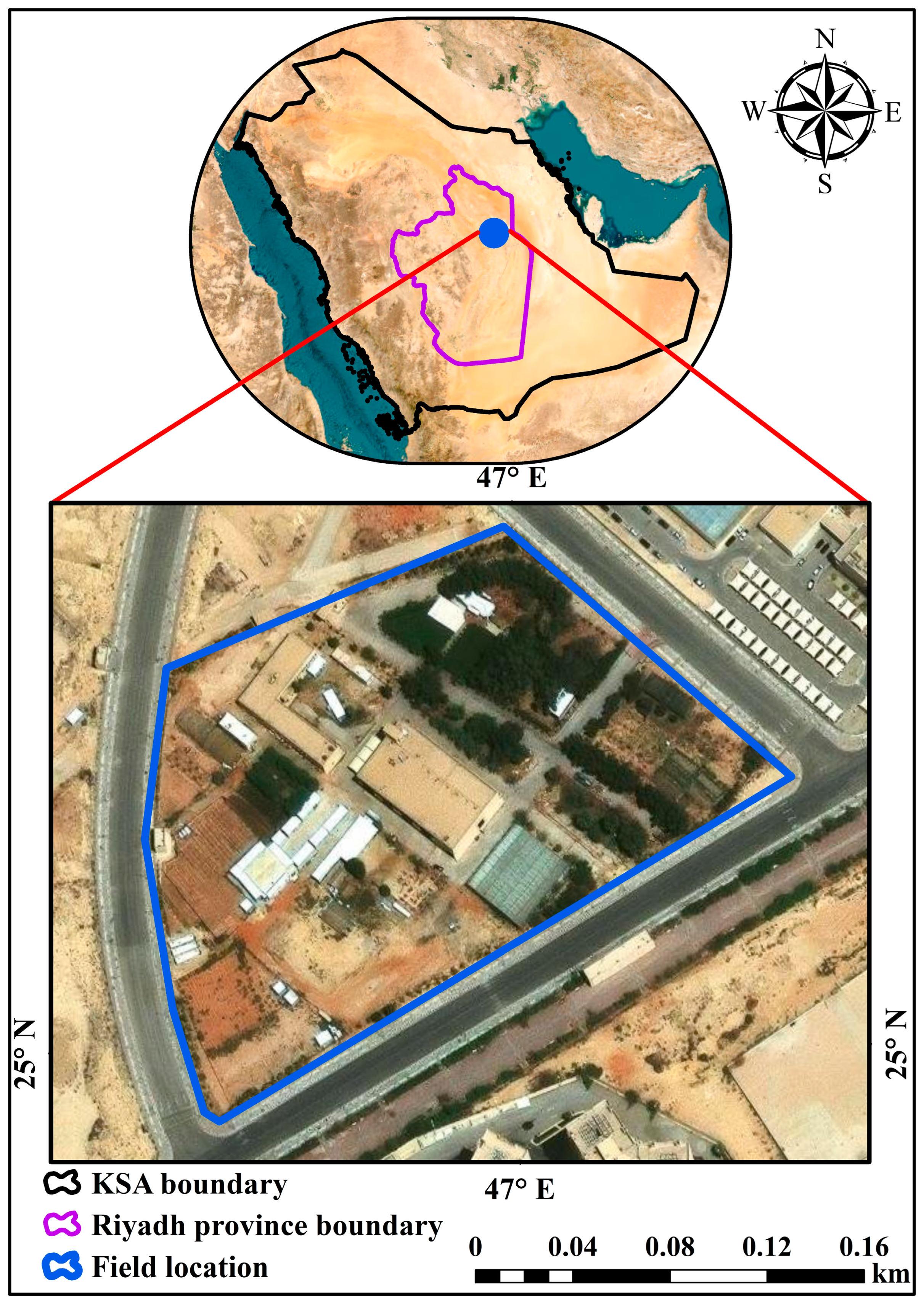
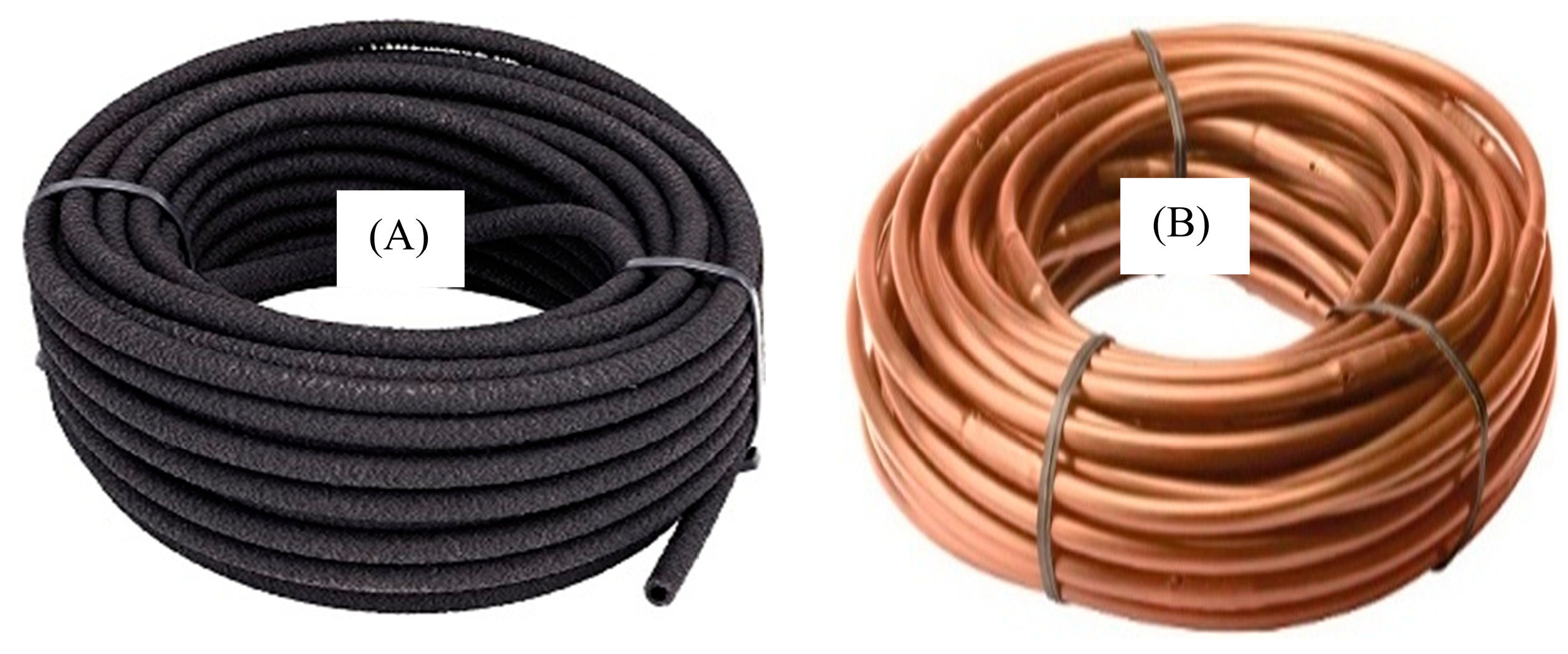



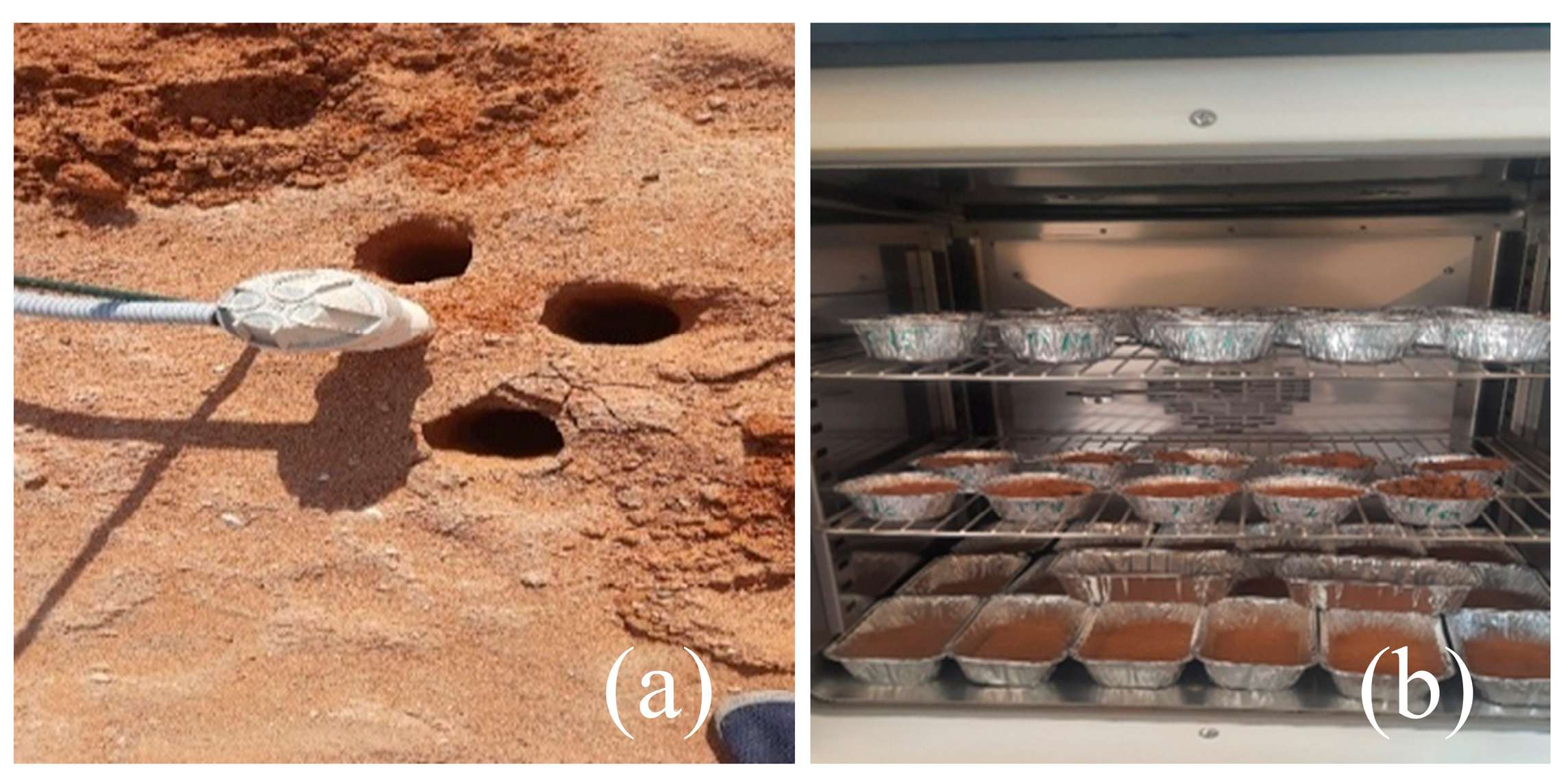

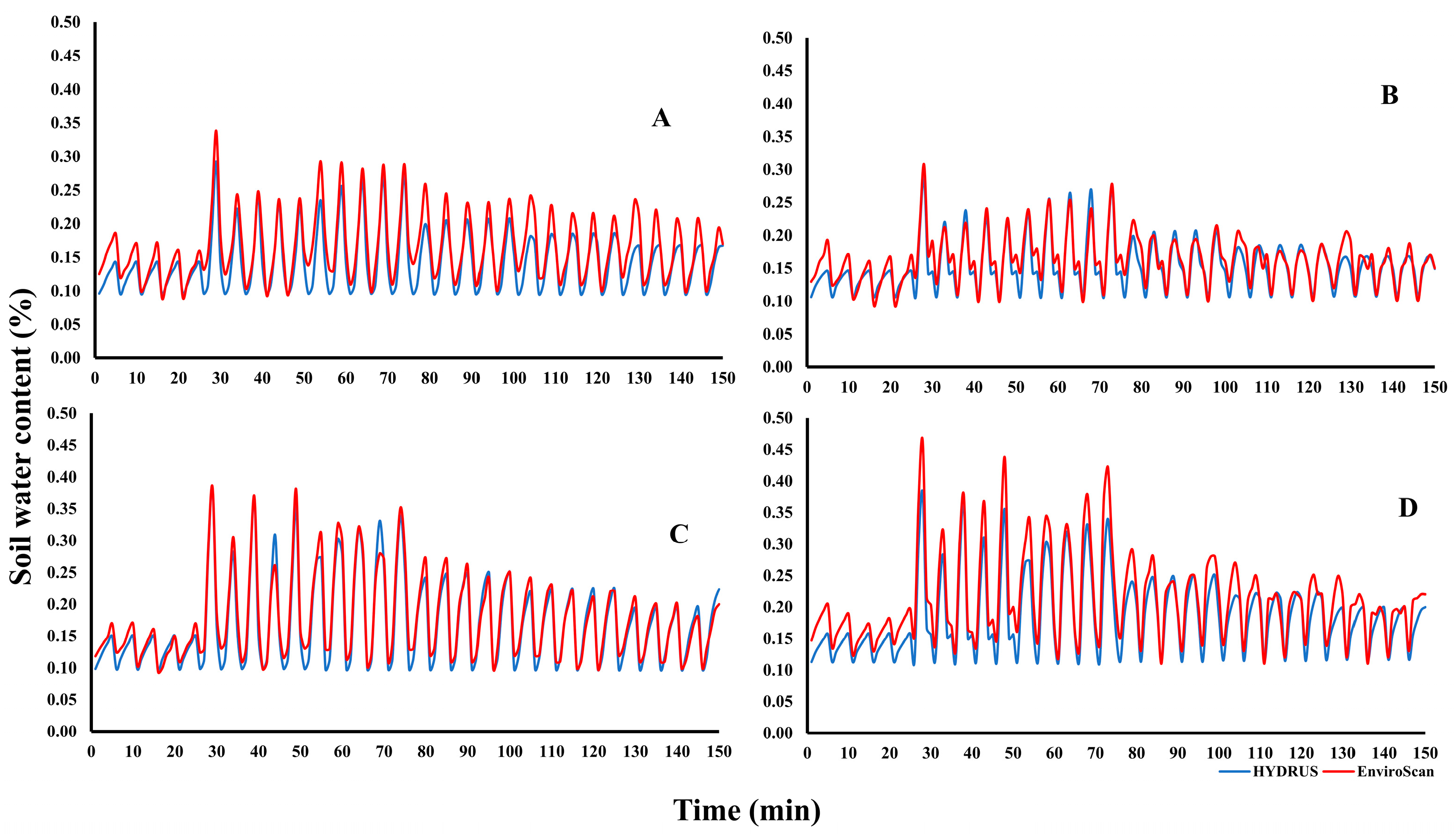
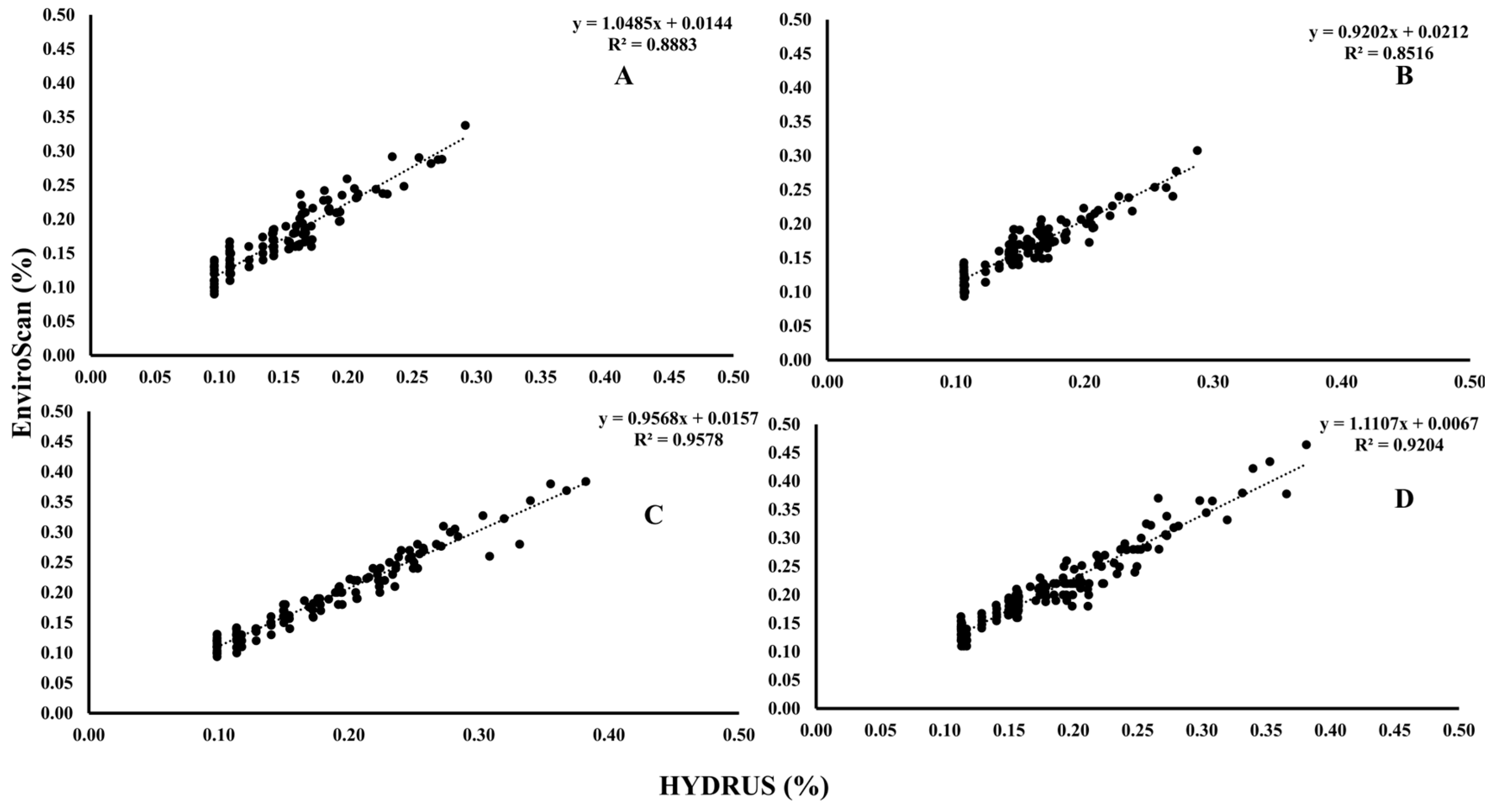

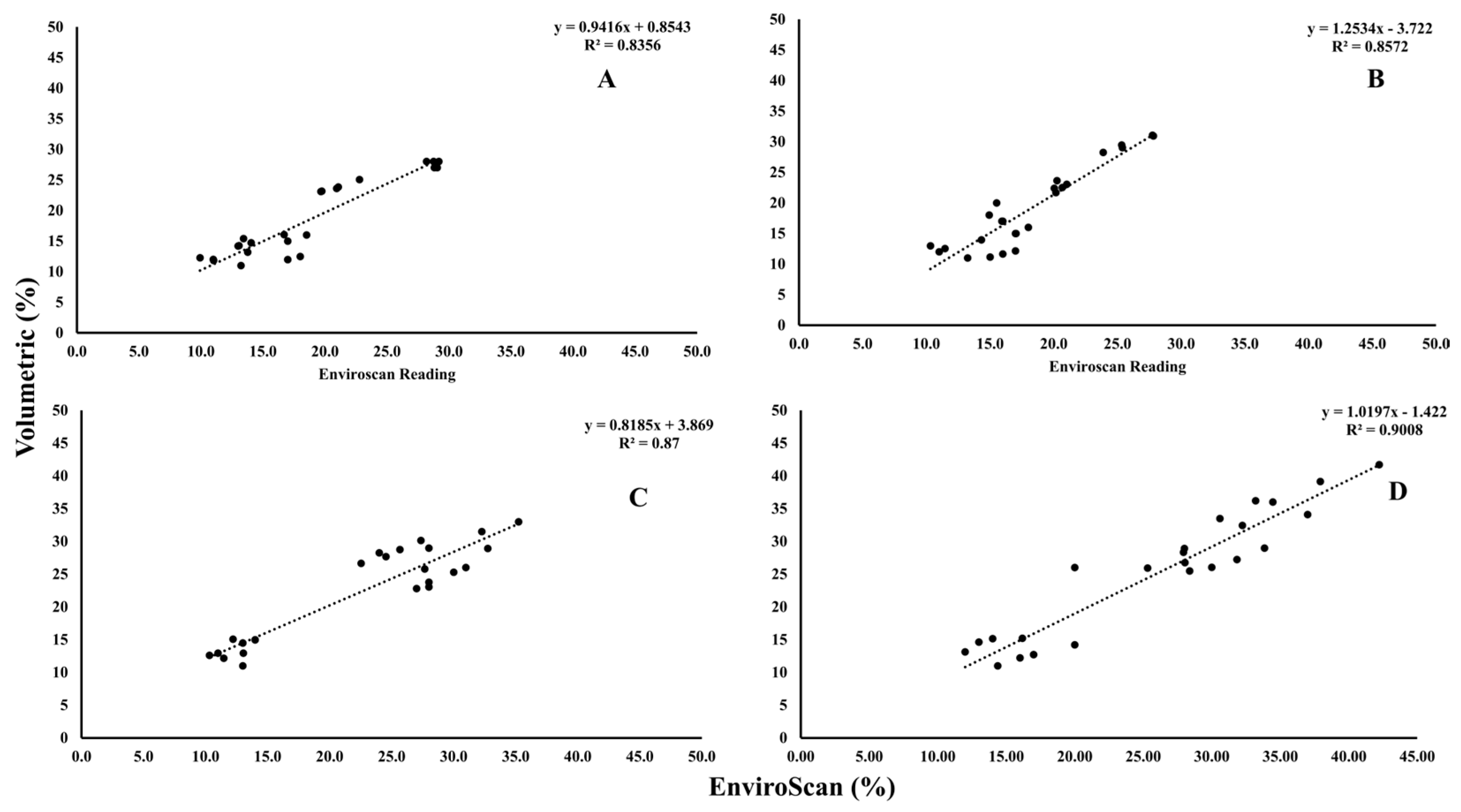
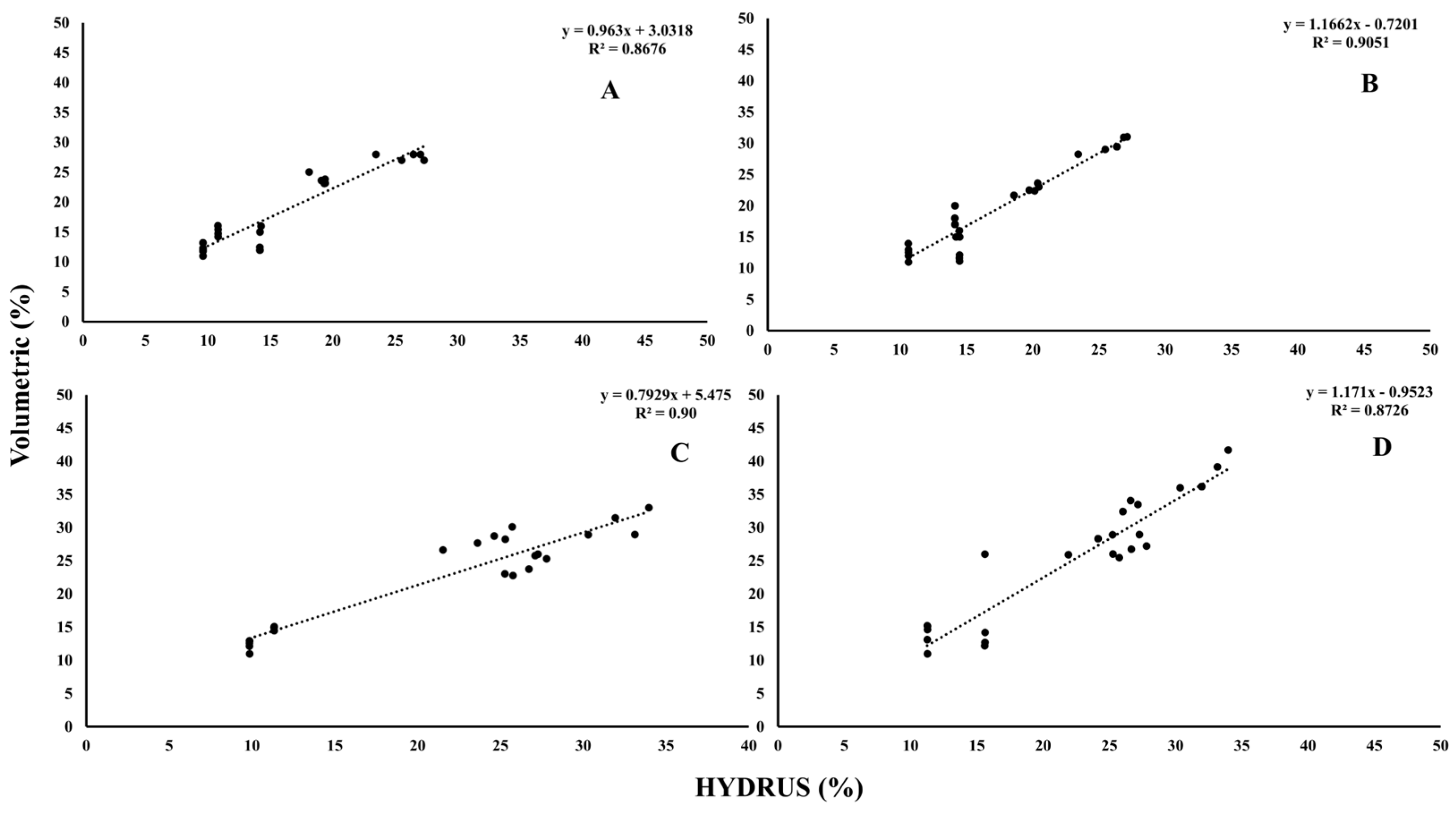

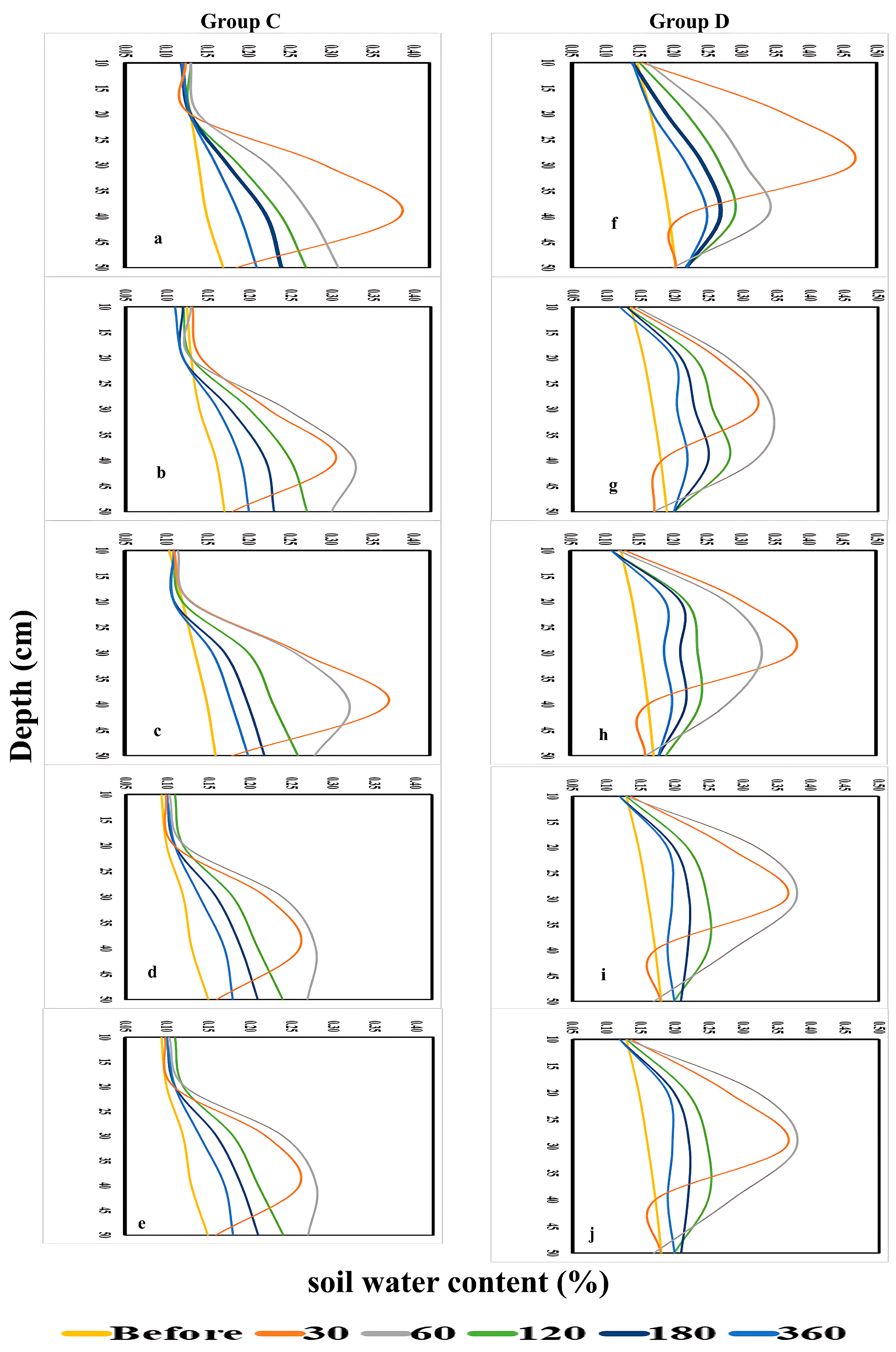


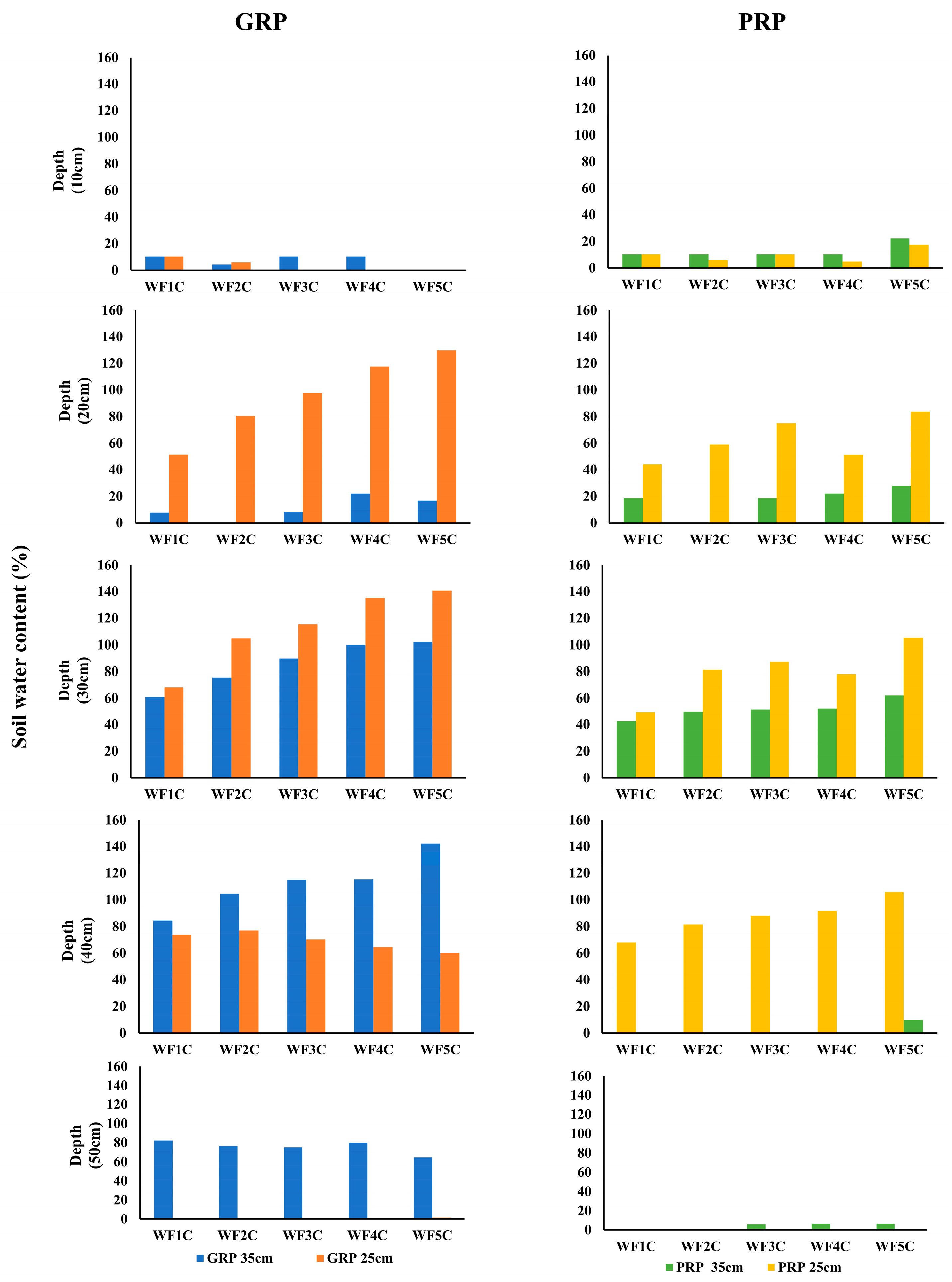

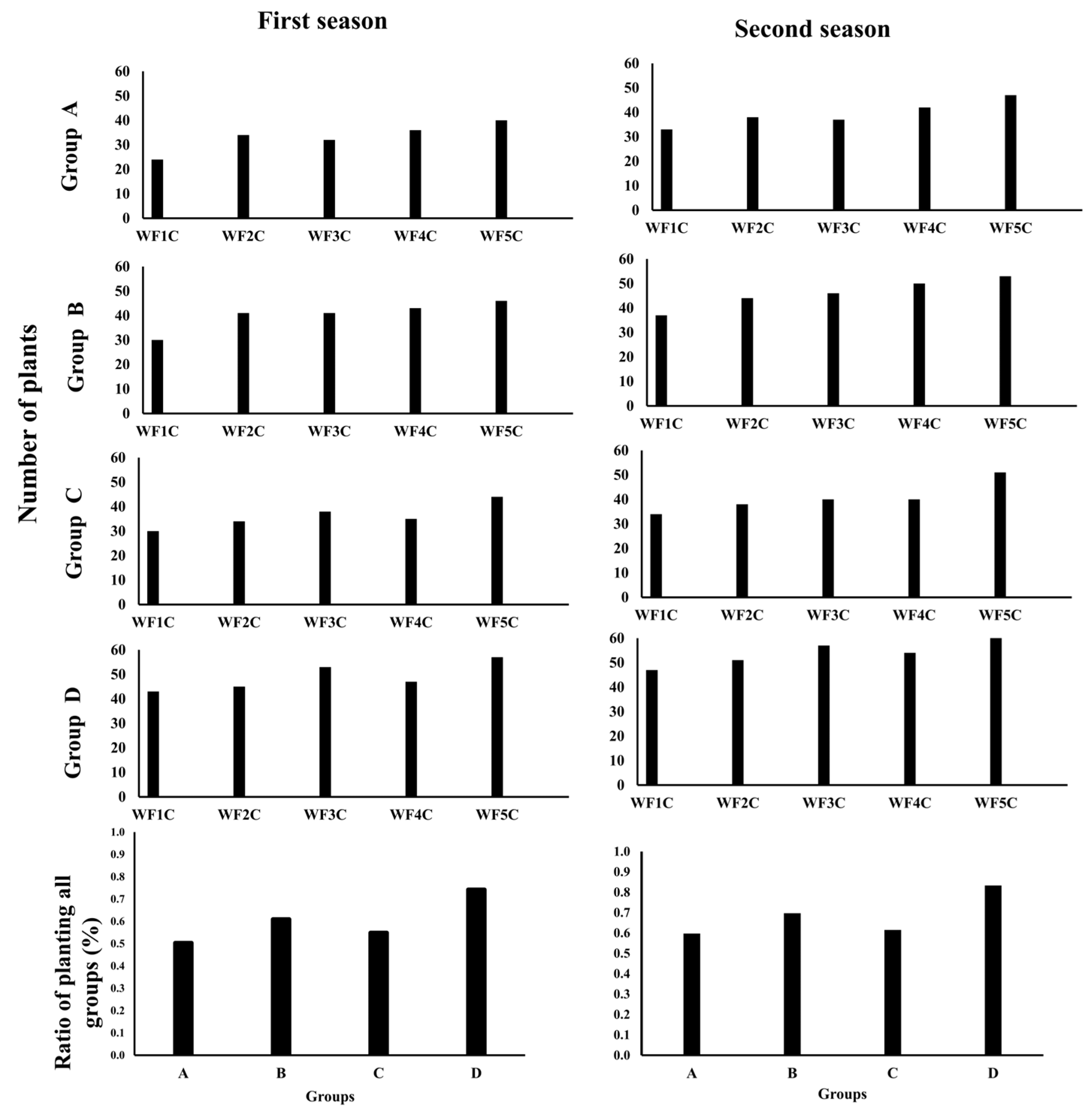
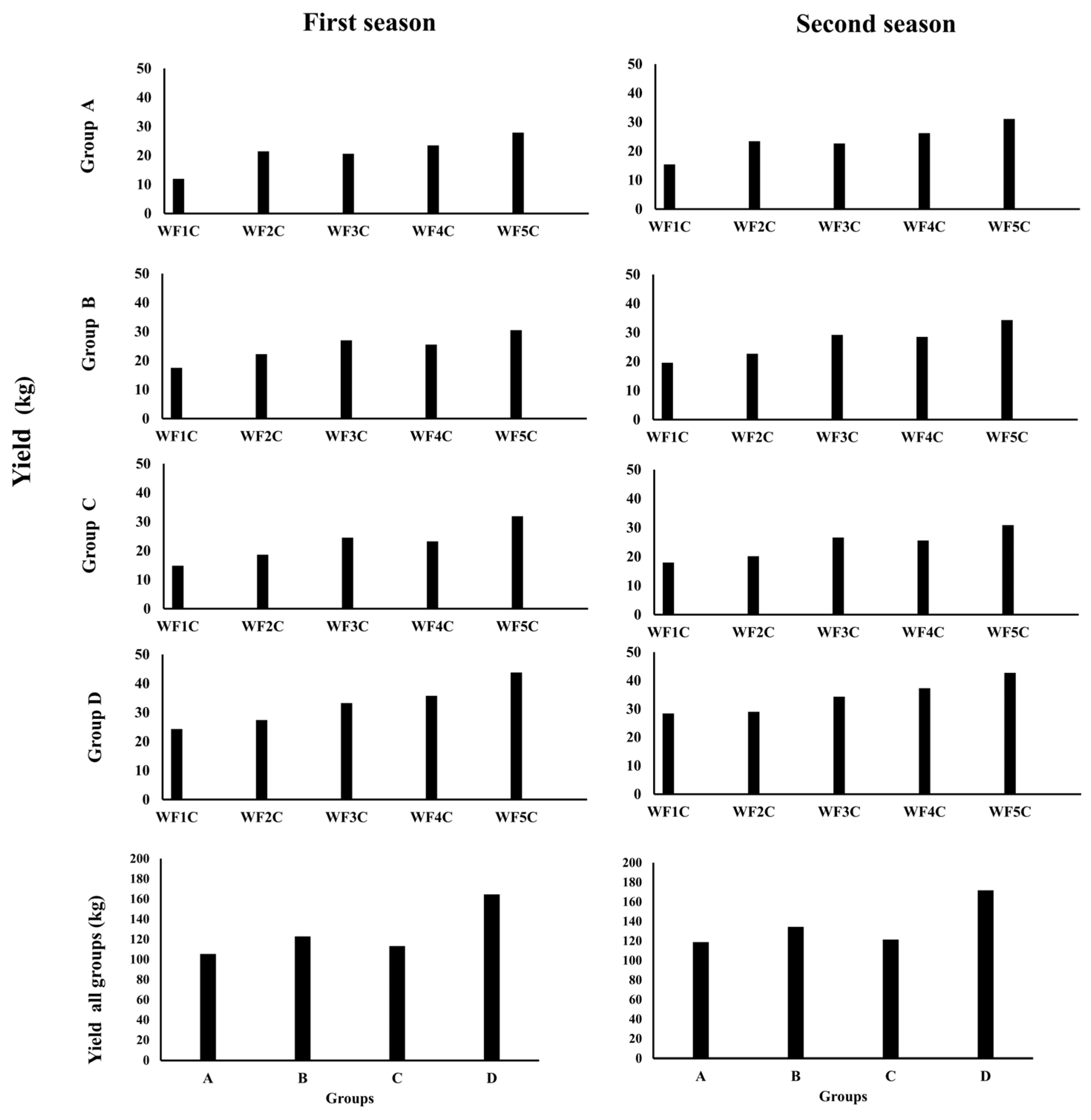
| WFC | Time (min) | 1 | 2 | 3 | 4 | 5 | ON (min) | OFF (min) | Total Time (min) | ||||
|---|---|---|---|---|---|---|---|---|---|---|---|---|---|
| ON | OFF | ON | OFF | ON | OFF | ON | OFF | ON | |||||
| WF1C25,35 | 30 | 30 | 30 | 0 | 30 | ||||||||
| WF2C25,35 | 15 | 15 | 15 | 30 | 15 | 45 | |||||||
| WF3C25,35 | 10 | 10 | 10 | 10 | 10 | 30 | 20 | 50 | |||||
| WF4C25,35 | 7.5 | 7.5 | 7.5 | 7.5 | 7.5 | 7.5 | 7.5 | 30 | 22.5 | 52.5 | |||
| WF5C25,35 | 6 | 6 | 6 | 6 | 6 | 6 | 6 | 6 | 6 | 30 | 24 | 54 | |
| Season | Group | Plant Count (Mean ± SD) | Weight (kg) (Mean ± SD) | Productivity (kg) | Germination Rate |
|---|---|---|---|---|---|
| First | A | 33.2 ± 5.0 | 21.9 ± 6.3 | 105.4 | 50.3% |
| B | 40.2 ± 6.7 | 24.8 ± 4.9 | 122.7 | 60.9% | |
| C | 36.2 ± 5.0 | 22.9 ± 6.4 | 113.2 | 54.8% | |
| D | 49.0 ± 5.5 | 32.9 ± 7.6 | 164.5 | 74.2% | |
| Second | A | 39.4 ± 5.0 | 23.7 ± 5.9 | 118.7 | 59.7% |
| B | 46.0 ± 6.5 | 26.9 ± 5.9 | 134.3 | 69.7% | |
| C | 40.6 ± 6.1 | 24.9 ± 5.4 | 121.3 | 61.5% | |
| D | 55.0 ± 6.5 | 34.7 ± 6.3 | 171.7 | 83.3% |
Disclaimer/Publisher’s Note: The statements, opinions and data contained in all publications are solely those of the individual author(s) and contributor(s) and not of MDPI and/or the editor(s). MDPI and/or the editor(s) disclaim responsibility for any injury to people or property resulting from any ideas, methods, instructions or products referred to in the content. |
© 2025 by the authors. Licensee MDPI, Basel, Switzerland. This article is an open access article distributed under the terms and conditions of the Creative Commons Attribution (CC BY) license (https://creativecommons.org/licenses/by/4.0/).
Share and Cite
Alazba, A.A.; Elnesr, M.N.; Shaban, M.; Alrdyan, N.; Radwan, F.; Ezzeldin, M. Field Assessment of Subsurface Intermittent Water Flow via Porous and Emitting Pipes. Water 2025, 17, 3143. https://doi.org/10.3390/w17213143
Alazba AA, Elnesr MN, Shaban M, Alrdyan N, Radwan F, Ezzeldin M. Field Assessment of Subsurface Intermittent Water Flow via Porous and Emitting Pipes. Water. 2025; 17(21):3143. https://doi.org/10.3390/w17213143
Chicago/Turabian StyleAlazba, A A, M. N. Elnesr, Mohamed Shaban, Nasser Alrdyan, Farid Radwan, and Mahmoud Ezzeldin. 2025. "Field Assessment of Subsurface Intermittent Water Flow via Porous and Emitting Pipes" Water 17, no. 21: 3143. https://doi.org/10.3390/w17213143
APA StyleAlazba, A. A., Elnesr, M. N., Shaban, M., Alrdyan, N., Radwan, F., & Ezzeldin, M. (2025). Field Assessment of Subsurface Intermittent Water Flow via Porous and Emitting Pipes. Water, 17(21), 3143. https://doi.org/10.3390/w17213143








